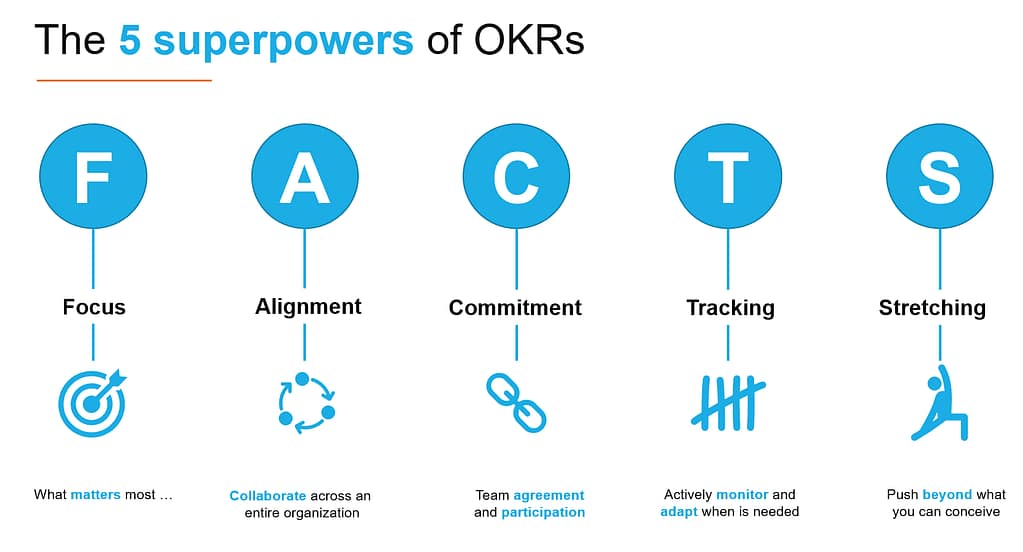In today’s fast-paced business landscape, organizations are constantly seeking ways to stay ahead of the competition and drive growth. One powerful tool that has gained significant traction in recent years is the Objectives and Key Results (OKR) framework. Pioneered by tech giants like Intel and Google, OKRs offer a structured approach to goal-setting that fosters focus, alignment, and accountability across teams and departments.
At its core, the OKR methodology encourages organizations to set ambitious yet achievable objectives and measure progress through quantifiable key results. By aligning individual and team efforts toward clearly defined goals, OKRs ensure that everyone is working towards a common vision, maximizing the impact of their collective efforts.

The benefits of adopting an OKR approach are numerous. It promotes transparency and open communication, as teams collaboratively set and track their objectives and key results. This empowers employees to take ownership of their goals and contributes to a culture of continuous improvement and learning. Additionally, the regular review and adjustment of OKRs allow organizations to remain agile and adaptable, pivoting their strategies as needed to stay ahead of market trends and customer demands.
Implementing OKRs is not without its challenges, however. It requires a shift in mindset and a commitment to embracing a data-driven, outcome-focused approach to goal-setting. Successful OKR adoption also hinges on effective communication, training, and a willingness to learn from mistakes along the way.
In this comprehensive guide, we’ll dive deep into the world of OKRs, exploring their origins, the nuances of crafting effective objectives and key results, and best practices for implementation and management. Whether you’re a seasoned OKR practitioner or new to this powerful framework, this article will equip you with the knowledge and strategies to unleash the full potential of OKRs and drive your organization’s success.

The OKR Methodology
The OKR framework is a deceptively simple yet powerful approach to goal-setting and performance tracking. At its core, it consists of two components: Objectives and Key Results.
Objectives are the qualitative, aspirational goals that an organization, team, or individual aims to achieve. They should be inspiring, challenging, and aligned with the overall strategic vision. Objectives typically answer the question “What do we want to accomplish?”
Key Results, on the other hand, are the quantitative metrics that measure progress toward the stated Objectives. They are specific, measurable, and time-bound, providing a clear indication of whether an Objective has been achieved or not. Key Results answer the question “How will we know we’ve achieved our Objective?”
The true power of the OKR framework lies in the interplay between these two components. By setting ambitious Objectives and defining measurable Key Results, organizations can maintain a laser-like focus on their priorities while fostering a data-driven, results-oriented culture.
OKR Formula

Characteristics of Well-Crafted Objectives and Key Results
To maximize the effectiveness of the OKR framework, it’s essential to craft Objectives and Key Results that meet certain criteria:
Objectives should be:
- Qualitative and inspirational
- Aligned with the organization’s vision and strategy
- Ambitious yet achievable
- Limited in number to maintain focus
Key Results should be:
- Quantitative and measurable
- Relevant to the associated Objective
- Ambitious yet realistic
- Time-bound with specific deadlines
Examples of Effective Objectives and Key Results
To illustrate the principles of well-crafted OKRs, consider the following examples:
Objective: Dominate the market for sustainable home products.
Key Result 1: Achieve a 25% market share in the sustainable home products category.
Key Result 2: Launch 5 new eco-friendly product lines by the end of the year.
Key Result 3: Increase online sales revenue from sustainable products by 40%.
Objective: Foster a culture of continuous learning and development.
Key Result 1: Ensure 90% of employees complete at least 20 hours of professional development training annually.
Key Result 2: Implement a mentorship program with 80% participation rate across the organization.
Key Result 3: Achieve an average employee satisfaction score of 4.5/5 in the annual engagement survey.
By following these guidelines and principles, organizations can effectively implement the OKR framework, setting the stage for focused execution, continuous improvement, and ultimately, sustainable growth and success.

Best Practices for Writing and Managing OKRs
Adopting the OKR framework is just the first step; ensuring its effective implementation and long-term success requires adhering to a set of best practices.
Setting Ambitious yet Realistic OKRs:
- Involve teams in the OKR-setting process to ensure buy-in and a realistic understanding of capabilities.
- Stretch goals are encouraged, but avoid setting unrealistic objectives that demotivate teams.
- Limit the number of objectives to maintain focus on key priorities.
- Align OKRs with the organization’s overall vision and strategy.
Regular Progress Reviews and Adjustments:
- Conduct weekly or bi-weekly check-ins to track progress and identify roadblocks early.
- Use a consistent scoring system (e.g., confidence levels) to quantify progress objectively.
- Be prepared to adjust or re-prioritize OKRs based on changing circumstances or new insights.
- End each cycle with a comprehensive retrospective to capture learnings and refine the process.
Transparency and Continuous Learning:
- Foster a culture of transparency by making OKRs visible across the organization.
- Encourage open communication and feedback to identify areas for improvement.
- Celebrate successes and failures alike, using them as opportunities for learning and growth.
- Invest in training and resources to continually upskill teams on the OKR methodology.
Balancing Adaptability and Commitment:
- Be adaptable in the face of changing market conditions, pivoting OKRs when necessary.
- However, avoid the temptation to change course too frequently, as commitment is crucial for achieving ambitious goals.
- Clearly communicate the rationale behind any adjustments to maintain alignment and buy-in.
- Strike the right balance between adaptability and commitment based on the specific context.
By following these best practices, organizations can maximize the value derived from the OKR framework, fostering a culture of accountability, continuous improvement, and sustainable growth.
Overcoming Common OKR Mistakes
While the OKR framework offers numerous benefits, its successful implementation can be hindered by several common pitfalls. Recognizing and addressing these mistakes is crucial for organizations to reap the full rewards of this powerful methodology.
- Setting Unrealistic or Vague Objectives: Mistake: Crafting objectives that are either too ambitious or too vague, leading to confusion and demotivation. Solution: Involve teams in the objective-setting process, ensuring objectives are challenging yet achievable and clearly defined.
- Misaligning OKRs with Organizational Strategy: Mistake: Failing to align OKRs with the company’s overarching vision and strategic goals, resulting in a disconnect between efforts and desired outcomes. Solution: Ensure OKRs are directly linked to and derived from the organization’s strategic priorities.
- Lack of Transparency and Collaboration: Mistake: Siloing OKRs within teams or departments, hindering cross-functional alignment and collaboration. Solution: Foster a culture of transparency by making OKRs visible across the organization and encouraging open communication.
- Inadequate Progress Tracking and Adjustments: Mistake: Neglecting to regularly review and adjust OKRs based on progress and changing circumstances. Solution: Implement a consistent cadence for progress reviews, using objective scoring systems and adjusting OKRs as needed.
- Tying OKRs Directly to Compensation: Mistake: Linking individual OKR achievement to compensation, leading to sandbagging or setting overly conservative goals. Solution: Decouple OKRs from compensation, using them as a tool for alignment, engagement, and continuous improvement.
- Using OKRs for Micromanagement: Mistake: Leveraging OKRs as a means of excessive top-down control and micromanagement, stifling employee autonomy and creativity. Solution: Empower teams to set their own OKRs aligned with organizational objectives, fostering ownership and accountability.
By proactively addressing these common mistakes, organizations can navigate the OKR implementation journey more effectively, maximizing the chances of success and reaping the full benefits of this powerful goal-setting framework.

The OKR framework has proven itself to be a powerful tool for driving focus, alignment, and accountability within organizations. By setting ambitious yet achievable objectives and quantifying progress through measurable key results, companies can foster a culture of continuous improvement, transparency, and data-driven decision-making.
Throughout this comprehensive guide, we’ve explored the core components of the OKR methodology, best practices for crafting effective objectives and key results, and strategies for overcoming common implementation challenges. We’ve emphasized the importance of involving teams in the goal-setting process, regularly reviewing and adjusting OKRs, and maintaining a delicate balance between adaptability and commitment.
Implementing OKRs is not a one-time exercise but rather an ongoing journey of continuous refinement and learning. As organizations navigate the ever-changing business landscape, the ability to pivot swiftly and align efforts toward shifting priorities becomes paramount. The OKR framework equips companies with the agility and focus needed to thrive in dynamic environments, empowering teams to work towards a shared vision while maintaining a relentless pursuit of ambitious goals.
We encourage you to embrace the OKR methodology and experience its transformative potential firsthand. Whether you’re a seasoned OKR practitioner or just beginning your journey, continuously refine your approach, learn from mistakes, and adapt to the unique needs of your organization. Remember, the path to success is paved with a willingness to experiment, iterate, and relentlessly pursue excellence.
We invite you to share your experiences, insights, and questions in the comments section below. Engage with our community of OKR enthusiasts, exchange best practices, and contribute to the collective knowledge that will shape the future of goal-setting and organizational success.